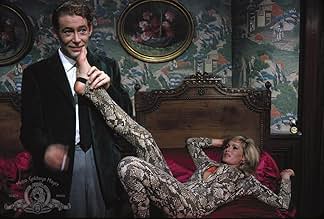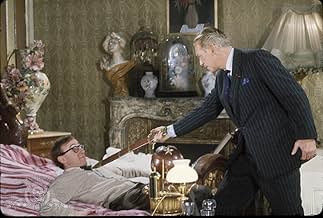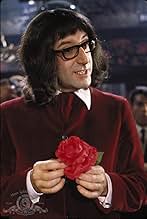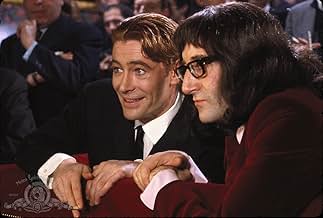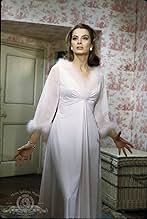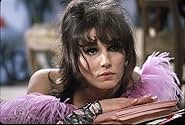Ein Playboy, der sich weigert, seine hedonistische Lebensweise aufzugeben, um eine Familie zu gründen und seine wahre Liebe zu heiraten, bittet einen verrückten Psychoanalytiker um Hilfe, de... Alles lesenEin Playboy, der sich weigert, seine hedonistische Lebensweise aufzugeben, um eine Familie zu gründen und seine wahre Liebe zu heiraten, bittet einen verrückten Psychoanalytiker um Hilfe, der selbst romantische Probleme hat.Ein Playboy, der sich weigert, seine hedonistische Lebensweise aufzugeben, um eine Familie zu gründen und seine wahre Liebe zu heiraten, bittet einen verrückten Psychoanalytiker um Hilfe, der selbst romantische Probleme hat.
- Für 1 Oscar nominiert
- 4 Nominierungen insgesamt
- Michael James
- (as Peter O'toole)
- Anna Fassbender
- (as Edra Gale)
- Mrs. Werner
- (as Eleonor Hirt)
- Marcel
- (as Jean Paredes)
Empfohlene Bewertungen
There is a bevy of beautiful women here. Paula Prentiss gets the most obviously outrageous role: a suicidal poetry-with-a-social-conscience writer who's also a performer at the Crazy Horse Saloon. The exquisite Capucine shows off her remarkable flair for physical comedy. Ursula Andress doesn't have to do anything other than show up in a bikini, but even she turns out to be a delightful comedienne. Romy Schneider doesn't fare as well. She looks amazing, but her character is cloying. She does shine, however, in the hilarious English-as- a-second-language class sequence.
There are some other gems: The nighttime courting below the window, the group therapy sessions, the library bully. The film comes to life at the end when it turns into pure slapstick. It contrives to assemble all the characters in a French château, with everyone chasing after each other in some cleverly devised sight gags. Just don't look for consistency, coherence, or continuity in this film. They don't exist. Enjoy it, instead, as a series of comic set-pieces.
What's New Pussycat was an international sex comedy with the usual huge, well known cast: Peter Sellers, Romy Schneider, Peter O'Toole, Ursula Andress, Paula Prentiss, Capucine, with a cameo by Richard Burton. This was Woody Allen's first produced film script and his first film role. It wasn't a happy experience.
Peter O'Toole plays Michael James, the British editor of a Paris magazine He is in love with Carole (Schneider). She wants to get married, but he can't commit to her. Women are constantly after him, and he is constantly giving in.
He sees one Dr. Fritz Fassbender (Sellers) who wants Michael's life, particularly one of his patient, Renee (Capucine). Carole, meanwhile, is friendly with Michael's friend Victor (Allen) who is crazy about her and also wants Michael's life. The whole thing converges at the Château Chantel one weekend.
This film is purportedly based on the love life of Warren Beatty and the title taken from the way he answered the phone. He obviously did not wind up making the film. Peter Sellers adlibbed through a great deal of the movie and took all of Woody Allen's funny lines, diminishing Allen's part. The two of them loathed one another.
What's New Pussycat started out hilariously, with funny dialogue and situations. As it went on, it became more and more of an annoying mess and went out of control, culminating in a Keystone Kops type scene that was very funny. However, what preceded it was disorganized insanity.
There definitely are funny scenes and good performances. Paula Prentiss is especially good, as is Allen. Sellers is great until he seems to veer off of the script. I'm not sure if Peter O'Toole did his own stunts, but some of what he did was fantastic - the role called for him to be very physical. He was quite funny. Romy Schneider as usual was the straight man to this chicanery.
Watch in the bar scene where Peter O'Toole and a man talk and O'Toole says, give my best to what's-her-name - it's Richard Burton, and the what's-her-name is guess who. Very cute.
I like slapstick, I like madcap, but I like it structured, so I'm not the best judge of this. I prefer the MGM Marx Brothers to the Paramount ones, for instance.
This was hard to take after a while.
The story turns out to be centered on a handsome man, Michael James (Peter O'Toole), who attracts women even more than he's attracted to them. He calls them all "pussycat", and that's about all he needs to do to have them ready to jump into bed with him. He's most in love with Carole Werner (Romy Schneider), who keeps pressuring him to get married, but he isn't ready to ditch his polyamorous ways, and he doesn't want to cheat on her after they're married. Michael's psychoanalyst, Dr. Fritz Fassbender (Peter Sellers), is also something of a womanizer, but women don't seem to like him near as much. Michael is also an acquaintance of Victor Shakapopulis (Woody Allen), who is moderately successful with women, but most importantly, he is also in love with Carole. The plot involves various sticky situations, so to speak, between these characters and various ancillary characters.
In addition to appearing as a co-star, Woody Allen wrote the script. This was his first real film. He had done a short called The Laughmaker in 1962, and a lot of television prior to What's New, Pussycat? and of course he had done a lot of stand-up. The script is good, at least on the "trees" level (as opposed to the "forest" level), and Allen's performance in his first film makes it easy to see how he became such a big star. He steals the film whenever he appears. O'Toole, who I've never been a very big fan of, tends to come across with an odd combination of stiffness and pretentiousness, despite Allen's good writing. Sellers seems as if director Clive Donner kept him in check a bit too much, and subsequently can seem lost. But Allen's now famous stock film personality shines through in his scenes. Performing his own comedy, even though he didn't direct, Allen's scenes flow, seem natural, have perfect timing, and are very funny.
Still, it might be difficult to not blame Allen for some of the overall messiness of the story--on the "forest" level. Donner starts with a scene that may be attractive visually--it features Sellers and his Wagnerian Viking wife bickering in their unusual home, shot from a wide angle so we can see the entire front of the house while they run around to from room to room, stairway to stairway--but the unusualness doesn't seem to have much point dramatically. That's indicative of problems to come. Donner too frequently blocks and shoots scenes at unfortunate angles. And there are far too many scenes that seem to be there just to be groovy or unusual, but they drag down the plot, sometimes almost grinding it to a halt.
As the film progresses, the complex relationships involving many different parties can become confusing. It doesn't help that some actors change their look--such as cutting their hair--as the film unfolds. Ancillary characters can come and go without warning and with little explanation. The climax depends on a large number of people heading to the same location, but for half of them, it's not at all clear why they head there, they just announce that they're going. The climax is still a bit funny, and it's one of the better and more complexly staged sequences, but it doesn't have anything like the impact it should. Story-wise, the film feels over before the climax even arrives.
As I just mentioned in my (more favorable) review of the same year's Dr. Goldfoot and the Bikini Machine, the 1960s, because of a number of factors including the near non-existent application of the dreaded Hays Production Code at this point and a general social atmosphere of experimentation, resulted in films that tended to be sprawling and experimental in their approach to such basics as plot. What's New, Pussycat? is a prime example. It often becomes clear that plot is being played with in a way that leads to occasional abandonment. In a way, What's New, Pussycat? is more just a collection of skits or scenarios, with a loosely related theme. While I'm a fan of experimentation and I admire the loosey-goosey, stream-of-consciousness attitude suggested, and Allen certainly satisfies my taste for absurdism in some of his scenarios (such as his birthday dinner), the fact remains that in this case, the plot experimentation just doesn't quite work.
The final judgment, however, is that I slightly recommend What's New, Pussycat? but primarily to see Allen's scenes and enjoy the writing of his scenarios. There are other attractors and interesting aspects, including the fact that Ursula Andress has probably never looked better than she does here (although she's looked as good), but like an unfortunate many of these 1960s "madcap comedies", What's New, Pussycat? should be approached with a bit of caution.
But even as an especially commercial production with a then modern pop soundtrack, which absorbed the movie lots of success (though the most memorable use, a Dionne Warwick track, was much overlooked), and a slapdash editing job, it has some impressive elements not limited to the wit and inspired silliness contributed by Woody. Peter O'Toole had already done Lawrence of Arabia, Becket and Lord Jim before this silly little farce, which was a cool and slick showcase of his range. He plays a strapping, earnest young man who struggles to remain faithful to his fiancé but cannot seem to avoid women who want to sleep with him. Peter Sellers plays his analyst, a Deutsche pervert who hates his nagging, brutish wife and proposes to follow his patient O'Toole and "study his behavior." Sellers provides one of his most hilarious performances, making it seem so easy to alternately embellish and subdue his Germanic caricature while completely inhabiting his ridiculous '60s swinger get-up.
So this is a classic screwball sex comedy of its time and captures the era not in the material, or even in production value, but in sight and sound. The movie was a box-office success, appealing of course to date moviegoers and mainstream audiences who saw the names Peter O'Toole, Peter Sellers, Capucine, Ursula Andress, Tom Jones and Burt Bacharach, but also, surely, to those who were cynical of the gender double-standard as well as Sellers' Teutonic psychiatrist. But yeah, definitely well worth a look, full of laughs.
Originally written by Woody Allen as a vehicle for Warren Beatty, both script and cast underwent a mighty change before it reached the screen, so much so that the experience prompted Allen to swear he'd never allow any one but himself to direct one of his scripts in the future. The story revolves around Michael James (Peter O'Toole), a handsome man who wants to marry Carol (Romy Schneider) but can't stop sleeping around long enough to make a commitment. He accordingly goes to psychiatrist Dr. Fritz Fassbender (Peter Sellers)--who is a sex-crazed nut in pursuit of patient Renee (Capucine.) Before the dust settles Woody Allen, Paula Prentiss, Ursla Andress, and Edra Gale are added to the mix.
O'Toole and Sellers are hardly challenged by the material and Allen introduces his "I'm a New York neurotic" screen persona for the first time--but it is really the abundance of supporting actresses that give the film what little zing it still retains. Romy Schnieder was among Europe's greatest stars and finest actresses of her era; although the script offers her little, she is charming indeed. Much the same can be said of the legendary Capucine in the role of a world-weary nymphomaniac; Ursula Andress, who arrives in the film via parachute, and bovine Edra Gale, who runs riot in Wagnerian attire. But the real scene stealer is Paula Prentiss.
Although extremely attractive, Prentiss was originally typed as a "second lead" of the Eve Arden type--but she quickly graduated to neurotic comedy roles for which she had a truly unique flair. WHAT'S NEW, PUSSYCAT? finds her at the top of her form as the interestingly-named Liz Bien, who writes bad poetry, has a tendency to overdose on pills every time she goes to the bathroom, and who attaches herself to the much-harassed Peter O'Toole. It really is a performance that transcends the material and which lingers in the mind long after the credits roll.
The DVD release is third rate, with mediocre visual elements and sound so uneven that I constantly adjusted the volume as I watched. When all is said and done, this is really a film for hardcore fans of its various stars--and especially for Paula Prentiss. If for no other reason, the film is worth watching for her alone.
GFT, Amazon Reviewer
Wusstest du schon
- WissenswertesRichard Burton: Uncredited, as man in a strip club. Burton appears with Peter O'Toole in a scene in a bar where Burton asks O'Toole, "Haven't you met me somewhere before?" O'Toole responds: "Yes - I can remember the name, but I can't quite place the face", adding, as he turns away, "Give my regards to what's-her-name". The dialogue is a reference to their appearance together in Becket (1964), and to Burton's wife at the time, Elizabeth Taylor.
- PatzerWhen the anarchist's bomb explodes, Carole does not react to it, although everybody else does.
- Zitate
Michael James: Did you find a job?
Victor Skakapopulis: Yeah, I got something at the striptease. I help the girls dress and undress.
Michael James: Nice job.
Victor Skakapopulis: Twenty francs a week.
Michael James: Not very much.
Victor Skakapopulis: It's all I can afford.
- Crazy CreditsThe opening/closing titles feature a host of Cupid cherubs in cat masks performing various gags.
- VerbindungenFeatured in Die Unverbesserlichen: Nichts dazugelernt (1966)
Top-Auswahl
- How long is What's New Pussycat?Powered by Alexa
Details
- Erscheinungsdatum
- Herkunftsländer
- Sprachen
- Auch bekannt als
- What's New Pussycat
- Drehorte
- Produktionsfirmen
- Weitere beteiligte Unternehmen bei IMDbPro anzeigen
Box Office
- Bruttoertrag in den USA und Kanada
- 18.820.000 $
- Laufzeit
- 1 Std. 48 Min.(108 min)
- Farbe
- Seitenverhältnis
- 1.66 : 1


